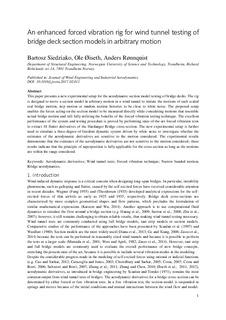An enhanced forced vibration rig for wind tunnel testing of bridge deck section models in arbitrary motion
Journal article
Submitted version
Permanent lenke
http://hdl.handle.net/11250/2462511Utgivelsesdato
2017Metadata
Vis full innførselSamlinger
Originalversjon
Journal of Wind Engineering and Industrial Aerodynamics. 2017, 164 152-163. 10.1016/j.jweia.2017.02.011Sammendrag
This paper presents a new experimental setup for the aerodynamic section model testing of bridge decks. The rig is designed to move a section model in arbitrary motion in a wind tunnel to imitate the motions of such scaled real bridge motion, step motion or random motion histories to be close to white noise. The proposed setup enables the forces acting on the section model to be measured directly while considering motions that resemble actual bridge motion and still fully utilizing the benefits of the forced vibration testing technique. The excellent performance of the system and testing procedure is proved by performing state-of-the-art forced vibration tests to extract 18 flutter derivatives of the Hardanger Bridge cross-section. The new experimental setup is further used to simulate a three-degree-of-freedom dynamic system driven by white noise to investigate whether the estimates of the aerodynamic derivatives are sensitive to the motion considered. The experimental results demonstrate that the estimates of the aerodynamic derivatives are not sensitive to the motion considered; these results indicate that the principle of superposition is fully applicable for the cross section as long as the motions are within the range considered.
